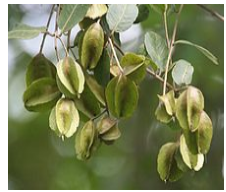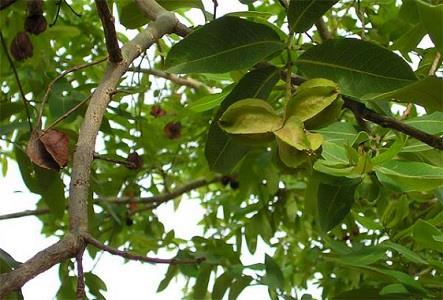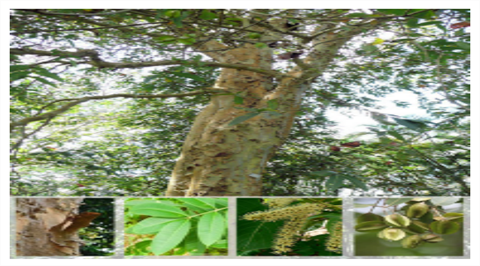ARJUNA
Contents
-
Introduction
-
Description of the tree
-
Puranic Reference
-
Ayurvedic uses
-
Significance
Introduction

Arjuna is one of the sacred trees in India. The Sanskrit Synonyms are: Arjuna, Viravriksha, Kukubha, Partha, Nadisarja. The scientific name is Terminal Arjuna. It belongs to the family of Cormbitacea.
The vernacular names of Arjuna tree are:
Hindi: Kahu, Arjuna
Malayalam: Karimaruthu, Thembava or Thenpavu Neermaruthu
Telegu: Thella Maddi, Nelamadu
Tamil: Marudha Maram
Kannada: Kamarakshi
English: Black Murdah or Indian Laurel
Bengali: Piasal or Usan
Marathi: Madal, Sadada
Oriya: Kolashahajo, Pondosa- Hajo, Sahajo
Punjabi: Arjan
Gujarati: Sadri, Hadri, Sajadio
Description of the tree
 The plant is native to India. It is a medium to large deciduous tree which grows up to a height of 20- 30 mts. It grows well in any type of soil. The tree sheds its skin and its wood becomes wood after the shedding. The bark is grey to black in colour with deep longitudinal fissures. The tree has straight stems with spreading branches and forms a wide canopy at the crown from which the branches drop downwards.
The plant is native to India. It is a medium to large deciduous tree which grows up to a height of 20- 30 mts. It grows well in any type of soil. The tree sheds its skin and its wood becomes wood after the shedding. The bark is grey to black in colour with deep longitudinal fissures. The tree has straight stems with spreading branches and forms a wide canopy at the crown from which the branches drop downwards.
The leaves are big, sub opposite, oblong and conical. The leaves which appear smooth are green on top and brown below. The flowers are seen in panicles of spikes and are greenish white or yellow in colour. The flowering season is from April- May. The Arjuna tree is mostly found on the river banks or near dry river beds in West Bengal, South and Central India. The tree is propagated through seeds. It takes 7-8 years for the tree to mature and be used for medicinal purposes. Seeds are best sown in a polythene bag during June- July and then transferred to land for better germination. The seedlings can be transplanted to land after a month.
Fruits have 5-7 wings and are ovoid (resembling the shape of an egg).
Puranic Reference
In Ramayana, there is a mention of Arjuna tree in Kishkinda Kanda – Sarga 1.
According to Bhagavata Purana, King Kubera, the god of wealth had two sons- Nalakubera and Manigriva. The wealth and power had made Nalakubera and Manigriva impudent and disrespectful of other devas. Once, when Sage Narada was passing by a river, he saw the two boys in an inebriated state, playing stark naked with the Gandharva girls in the river. The boys being intoxicated and engrossed in their play with the Gandharva girls, ignored Sage Narada. Sage Narada thus decided to teach the young boys a lesson. The sage felt that poverty is the only punishment for people who are intoxicated by wealth and power. So, he cursed the young boys to be Arjuna trees and said that they would get back their original form after 100 years with the touch of Lord Sri Krishna.
Thus due to the curse, the sons of Kubera became Arjuna trees. Years passed by and once Lord Krishna was fastened to a husking machine, when His attention was drawn to the Arjuna trees nearby. He remembered the words of Sage Narada, and approached the trees along with the husking machine tied to Him. Lord Krishna placed Himself between the two trees and uprooted both the trees. When the trees fell down, the spirits of Nalakubera and Manigriva emerged out of the trees and prayed to Lord Krishna for having liberated them from the curse. The liberation of the sons of Kubera from the Arjuna tree with the touch of Lord Krishna makes the Arjuna tree sacred.

Ayurvedic uses
It was Vagbhata during 7th Century CE who introduced the Arjuna tree to Ayurveda. In the Ashtanga Hridayam, (eight sections of Ayurveda) Vagbhata recommends the use of Arjuna in the powder form for treating wounds, haemorrhages and ulcers. Bark leaves and fruits of the tree are used in medicinal preparation. The fruits of the tree are used to treat Asthma, constipation and intestinal worms. The tree is known for its efficacy in treating cardiac related problems. The bark of the tree is said to possess antibacterial, anti fungal, anti- pyretic, astringent and antimutagenic properties. It acts as a natural rejuvenator by replacing the dead or weak cells in the body with healthy and new cells.
Arjuna tree consists of active constituents such as tannins, triterpenoid saponins (arjunic acid, arjunolic acid, arjungenin, arjunglycosides), flavonoids (arjunone, arjunolone, luteolin), gallic acid, ellagic acid, oligomeric proanthocyanidins (OPCs), phytosterols, calcium, magnesium, zinc, and copper.1,2.
Ayurvedic properties of Arjuna tree are as follows
Rasa (Taste): Tikta, (astringent) Kashaya (Bitter) Guna: Rooksha, Laghu (Light) Virya (effect): Cool
It is used to balance all the three doshas: Kapha, Vata and Pitta.
Arjuna tree is used in the treatment of the following ailments/symptoms:
-
Heart diseases: The extract of the juice from the bark is rich in Co-enzyme Q-10. It is the main enzyme to treat heart diseases. Regular intake of the extract of the bark strengthens the heart muscles, corrects erratic heartbeat, prevents or lowers the formation of blood clots, reduces blood pressure and cholesterol. It prevents the hardening of the blood vessels, thus preventing strokes and heart attack. The thick bark extract mixed with milk when taken in the morning on an empty stomach improves cardiac functioning. If fresh juice is not available, then 2 gms of dried powder of the bark along with milk has the same effect.
-
Asthma: Regular intake of 1-2 grams of the Arjuna bark powder along with milk payasam or rice pudding is a permanent cure for Asthma.
-
Skin Care: For the treatment of acne, or dark spots on the skin, a mixture of the bark powder along with honey is highly beneficial. The mixture not only removes acne, but also improves the complexion of the skin.
-
Cough: A pinch of the bark powder mixed with ghee and honey is effective in treating cough. It can be used to treat tubular cough also. A mixture of rice water, sugar, red sandalwood powder along with Arjuna powder helps in treating haemoptysis (act of coughing up blood or blood stained sputum). This mixture will heal the ulcer in the lungs, and also stop the infection from spreading.
-
Palpitations: Raw bark of 10- 12 gms or 5-6 gms of dry bark mixed with 250 ml of milk and 500 ml of water should be boiled and reduced to 125 ml and consumed during the afternoon. This is an immediate cure for reducing palpitations. It is also effective in treating anxiety and stress.
-
Sexual health: The bark powder mixed with milk is beneficial for improving sexual apathy. The decoction of the bark provides relief in Spermatorrhea.
-
Ear pain: Two drops of the extract of the tender leaves of Arjuna tree are effective in relieving ear pain.
-
Abscess: An extract of the leaves applied on abscess or a paste of the leaves applied on the wound hastens healing. Alternately, the bark powder could be made into a paste and applied on the wound.
-
Improve digestion: For all intestinal problems, like indigestion, abdominal pain, constipation, consumption of a mixture of Arjuna powder mixed in water is effective.
-
Chronic Dysentery: For blood in the stools, a concoction of the bark powder mixed in goat’s milk is effective.
-
Fracture or sprain of bones: Eating 2-3 gms of the bark powder mixed with half a teaspoon of ghee and quarter cup of milk, relieves pain during fracture of bones. As the herb is a rich source of calcium, intake of the Arjuna bark powder strengthens the bones after fracture.
-
Oral care: A paste of the leaves applied on the gums strengthens the gums and stops bleeding of the gums.
-
The astringent property of the leaves provides relief from fever, bleeding piles, excessive bleeding bleeding during menstruation, leucorrhoea and bleeding wounds.
-
Liver Tonic: The extract of the bark is used as a tonic to treat liver cirrhosis. Regular intake is said to improve the liver functioning.
-
Urinary tract infection: A decoction of the Arjuna bark is used to treat burning sensation while passing urine, other urinary tract infection. It is also effective in treating urinary bladder and renal stones. It is used as a diuretic, thus used to treat oedema.
-
Balances mood swings: The extract of the leaves is used to treat emotional imbalance.
Other usesThe leaves are fed on a moth- Antheraea Paphia which produces tassar silk used for commercial purposes.
The tree is also used as fuel.
A gel like fluid is obtained when the bark is cut. The gel on drying turns to amber coloured gum from light –yellow colour. The gum is used as a purgative and adhesive. In Sidha form of medicine, the bark, leaves and gum are used to treat fever and earaches.

Significance
According to Vaasthu Shastra, Arjuna is one of the trees among other plants like "Palas", "Kanchana" Sleshmantaka and "Karanji that should not be planted within the limits of a house.

Ref: http://en.wikipedia.org/wiki/Terminalia_arjuna
http://www.indianetzone.com/38/arjuna_asana_plant.htm
https://herbtime.wordpress.com/2010/02/08/arjun-terminalia-arjuna/
http://www.bgardener.com/arjun-useful-medicinal-plant-tree.html#
http://www.linksyard.com/super-medicine-arjun-terminalia-arjuna/
http://www.shridharastro.com/art6.php
http://www.ayurveddoctor.com/herbal-medicinal-plant-arjuna.html
http://www.arvindguptatoys.com/arvindgupta/shaktigupta.pdf
http://en.wikipedia.org/wiki/Flora_of_the_Indian_epic_period
